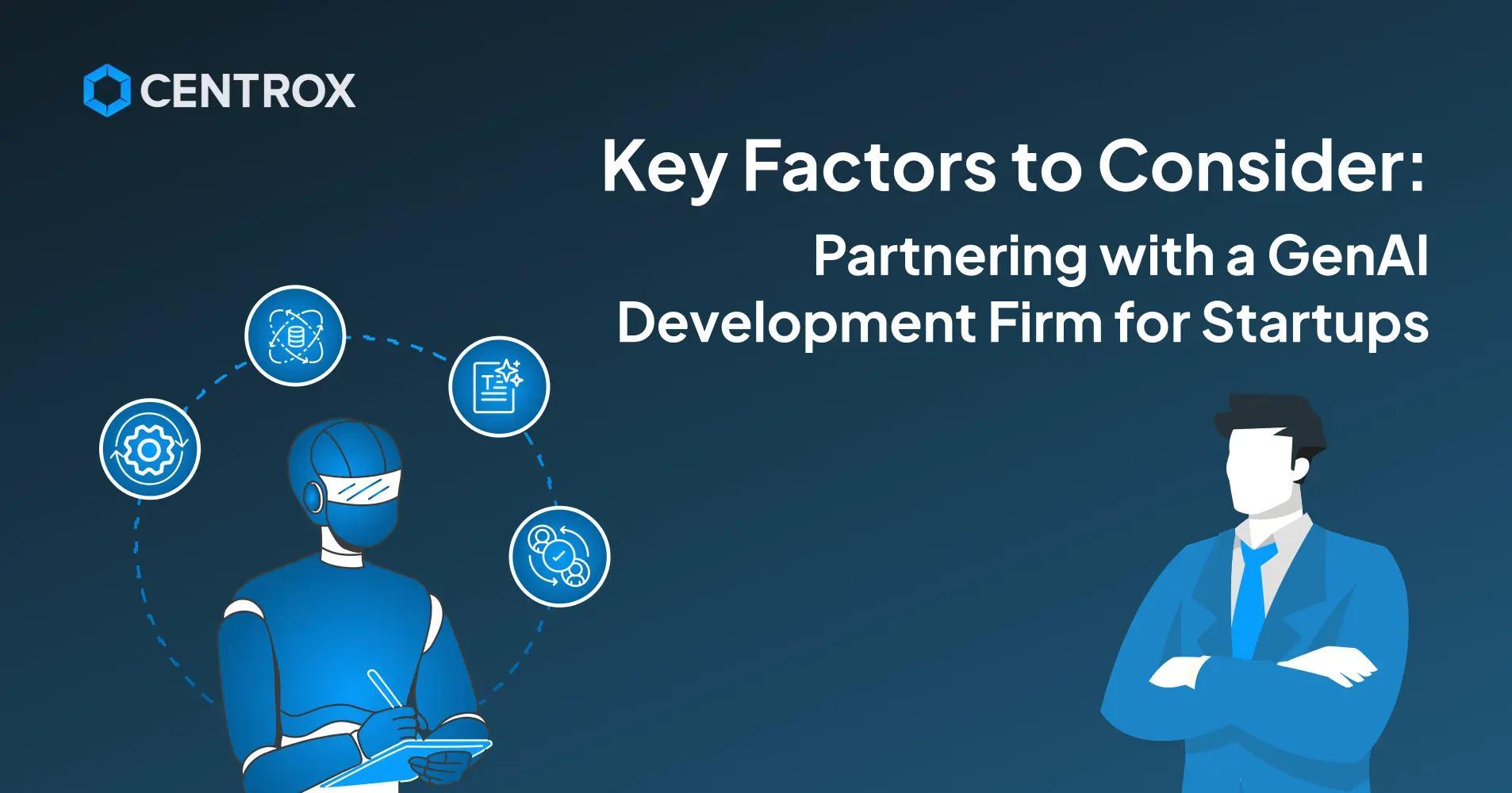Key Factors to Consider When Partnering with a Gen AI Development Firm
Learn Gen AI basics, its lifecycle, and how to choose the right Gen AI development firm to future-proof your startup.
4/25/2025
artificial intelligence
9 mins

Generative AI isn’t a buzzword anymore. It’s a technology that has taken over any and every industry by storm and has become an integral part of that industry in one way or another. The significance and importance of generative AI, aka Gen AI, can be gauged through the quote of Microsoft’s CEO Satya Nadella, who, in a recent interview, said that AI Agents will replace traditional SaaS applications.
With such significance, businesses don’t have a choice of whether or not to incorporate Gen AI into their existing tech stack. To do so, they’d either have to build in-house Gen AI talent or hire a Gen AI development firm that can do that for them.
Before we dive into details, here’s a quick overview of what you’ll be learning and exploring in this blog article:
- Gen AI 101 for Business Leaders
- Before discussing using Gen AI, it’s immensely important for business leaders to understand this technology. We’ll cover the basics.
- Gen AI lifecycle
- Gen AI has a systematic development process. Understanding that is important for business leaders to make better decisions about this technology. We’ll cover
- Scope definition
- Model selection
- Model training
- Model integration
- Gen AI has a systematic development process. Understanding that is important for business leaders to make better decisions about this technology. We’ll cover
- What to Look for in a Gen AI Development Firm
- Finally, we’ll cover what skills and characteristics to look for in a Gen AI development firm before partnering with them. Skills and characteristics such as technical competency, project management, communication skills, and more.
By the end, you’ll have a solid understanding of what gen AI is as a business leader of today and what to look for in a gen AI development firm to usher your company into the era of AI and beyond.
Generative AI 101 For Business Leaders
If you're a business currently in research mode and curious to know how and in what ways Generative AI can be incorporated into your existing workflows and processes, then this section is for you. I’ll briefly explain what Gen AI is, how it works, and share some example use cases.
Difference Between AI and Generative AI
Artificial Intelligence (AI) is a technology that, as the name suggests, mimics the cognitive ability of the human brain to reason and make decisions. The goal with AI now is to reach what we call Artificial General Intelligence (AGI), where machines will be as smart as humans, if not more so, in cognitive ability.
A branch of Artificial Intelligence is Machine Learning, which focuses on building models that are trained on large amounts of existing data to such an extent that, when a similar situation is brought in front of it, based on the data it is trained on, it can generate new outcomes.
Within Machine Learning, there are two main approaches: supervised learning, where the data used to train models is labeled, and unsupervised learning, where we train models on unstructured data and build their capabilities to make sense of it by forming clusters.
Generative AI is a semi-supervised (trained on both labeled and unlabeled data) learning technology that can generate content in multiple forms, such as text, audio, and video. Even the long-forgotten ChatGPT 3.1 was trained on almost all the data that exists on the internet, let alone its successor versions, which are far more advanced.

The Gen AI Development Process
By this time, you have enough context and understanding of Gen AI to decide if your existing use case or problem can be solved through this technology or not. If the answer is yes, that leads to a follow-up question, which is adopting one of the following routes:
- Building in-house Gen AI development competencies, which can be extremely challenging
- Or hiring a Gen AI development firm to build your solution
This article aims to provide you with the understanding and information you need to make the right decision when choosing a generative AI development firm. To that end, I need you to take a quick look at the overall generative AI development process.
Generative AI projects start with defining the scope. You need to be very clear about the problem you are trying to solve. One of the main reasons this step is so critical is the sheer diversity of Gen AI models to choose from. These models can be used for a variety of use cases, ranging from text generation to image and video generation. This is why a well-defined use case allows you to pick and choose the right AI model from the start, saving time, effort, and cost later in the project.
Once the right model is chosen, the next step is aligning and adapting that model to your proprietary data or the specific dataset required to train the model well enough to serve your unique use case. Multiple techniques and procedures are included in this phase—from prompt engineering to fine-tuning and aligning with human feedback. Each technique plays a critical role in helping the model better understand the nuances of your data and use case.
Once the model is ready, the final step is to integrate it into your application and augment it with Gen AI capabilities. This involves embedding the model into your existing infrastructure so that your application can fully leverage the generative potential of AI.
This entire Gen AI development lifecycle’s success is contingent on having access to the right data, selecting the appropriate model, and having ample computational resources. Any weakness in these areas can severely impact your project outcomes.
What Makes a Gen AI Development Firm Great?
The short answer to what you should look for in a Gen AI development firm is their competency at each stage of the Gen AI development lifecycle, in addition to, of course, their ability to manage your project well, communicate clearly, and align with your existing workflows.
Let’s zoom in on each stage of the Gen AI development lifecycle and see what core competencies a Gen AI development firm must have for it to be chosen over the others.
Scope
The first—and arguably the most significant—step in the overall Gen AI development process is defining the scope. If this goes right, everything goes right; and if it goes wrong, everything that follows suffers. While part of the scope definition is about you being clear about your own needs, a huge part of it depends on the firm being sharp enough to understand your pain points, your specific challenges, and your desired outcomes to tailor the Gen AI lifecycle to fit your unique use case.
If a beef burger is what you’re craving, you shouldn’t be served a beef steak instead. And that can only happen if the chef understands your taste buds and knows exactly what to prepare to satisfy them. Similarly, the Gen AI development firm needs to understand what you need at a deep level.
Selection
Setting the right scope paves the way for making the right choices, especially when it comes to model selection. There are a plethora of Gen AI models out there, each with its unique capabilities. For image generation alone, you can find a ton of models. (You can check out Hugging Face’s Gen AI model directory for more information.). Image generation, by the way is one type of generative AI with text and video being other.
So, a Gen AI development firm that isn’t just riding the Gen AI wave but is actually competent in this craft won’t struggle when it comes to choosing the right model for your use case. This decision involves several factors, including your available processing power, your current tech stack, your budgetary constraints, and the type and quality of your dataset.
Adapt and Align Models
Training a model takes time. It can take weeks or even months to train and test a model until it produces the kind of output you’re aiming for. An inexperienced agency may spend all that time training the model on the wrong dataset—or on a low-quality dataset that doesn’t serve your use case—leading to a waste not just of computational resources, but also your time and budget. These are critical constraints you have to keep in mind when building these solutions.
Integration
The Gen AI development firm should have enough technological competency in other areas of IT as well, including software development and cloud infrastructure, to be able to deploy the trained model into your existing software and systems seamlessly. Without this ability, even a well-trained model can become useless if it can't be deployed and integrated effectively.
In addition to these core areas, here are some additional skills and characteristics to look for:
Communication
The Gen AI development firm needs to be exceptionally good at communication, both in understanding and receiving requirements and in clearly communicating deliverables, outcomes, and progress. Communication lies at the heart of ensuring that the client and the firm remain on the same page and are moving toward a common goal throughout the engagement.
Project Management
Gen AI projects take time and require a lot of computational power and skilled human resources to do things right. Solid project management capabilities are essential—otherwise, missed deadlines, wasted resources, and continuous frustration will become a way of life for you. The firm must manage complexity and timelines effectively to deliver meaningful outcomes.
If you’re a business in the market for a Gen AI development firm, this article has, we believe, given you enough content and insight to help you make the right decision about the kind of Gen AI solution you need and who to hire to build that for you.
If you’re curious to learn more, you can book a free consultation here with our AI expert. If, by the end of that session, you think we can be a good fit for you, we can certainly explore potential synergies.

Muhammad Harris
Muhammad Harris, CTO of Centrox AI, is a visionary leader in AI and ML with 25+ impactful solutions across health, finance, computer vision, and more. Committed to ethical and safe AI, he drives innovation by optimizing technologies for quality.
Do you have an AI idea? Let's Discover the Possibilities Together. From Idea to Innovation; Bring Your AI solution to Life with Us!
Your AI Dream, Our Mission
Partner with Us to Bridge the Gap Between Innovation and Reality.
